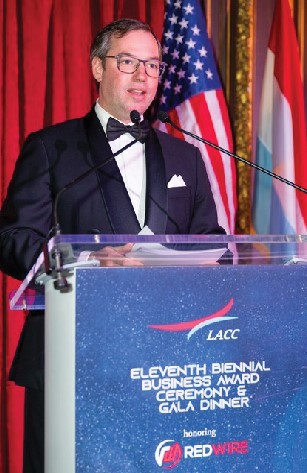Why Did the Elf Cross the Road?
by Lou Zacharilla
New York City, NY, May 17. 2024--If you happen to be driving in Iceland admiring its celestially-favored coastal landscape with deeply indented by bays and fiords, you will notice, as you head toward the inland plateau, that along the straight road of a major highway you, your automobile and the highway will slowly but surely curve widely for no apparent reason. No danger in the landscape justifies this arching curveball thrown into the road.
But there’s a reason. An unexpected one.
“To believe that what has not occurred in history will not occur at all, is to argue disbelief in the dignity of man.” – Mahatma Gandhi
In this country with sufficiently high GDP thanks to the industrious organization of its tourism, aluminum smelting and fishing industries, where irreligion grows steadily - to the point where more than 30% of the people identify as “not religious” - six out of every 10 of these disbelievers do believe faithfully that the government should spend significant amounts of highway construction and maintenance monies curving these roads in order to avoid hitting wandering Elves.
I’ll repeat that.
Iceland spends good-old taxpayer money to ensure that its Elf population meets no harm while crossing the road. It begs the joke, “Why did the Elf cross the road?”
It also begs the question of why people so hearty and smart in so many ways spend their government’s money like this. I have asked. There is no good answer.
So, to keep from dissing this fine nation, let’s conclude that each culture has its churlishly elfish whims and peculiarities.
 |
|
|
His Royal Highness Prince Guillame of the Duchy of Luxembourg speaking at the the Luxembourg American Chamber of Commerce Gala Dinner. |
In my neck of the woods here in the USA and in places like Japan, India and China – even Nepal - we spend money and invest to go into Space. While there are millions who question this as foolhardy as protecting the Elf population, it is our core belief that building, launching and managing satellites to assist with the logistics for and measurement of maritime cargo, road construction and as we learned at last month’s New York Space
Business, QCS (quantum clock synchronization) to replace GPS is of great value to our economy and spirit of commercial endeavor.
We are there. Despite a drop in overall venture capital investment the past 36 months, commercial Space is experiencing the emergence of a genuine private infrastructure. A “platform” for our deepest urges and shallowest cravings to create more wealth here on Earth. As Seinfeld says, “Nothing wrong with it.”
For sure. Many, many things are right with it.
Nations large and small are committing themselves to space-related economic development clusters as part of their national growth and development plans.
The past few years has seen the Grand Duchy of Luxembourg, home to satellite operator giant SES, take the lead in strategic moves and bending the road in their favor.
Along with its Trade & Investment Office of New York and the Luxembourg Space Agency, the Luxembourg American Chamber of Commerce in New York brought awareness to the beauty and importance of Space infrastructure by doing something it had never done before. In April it gave its biennial business of the year award to a Space company!
The recipient, Redwire, picked up the award at a splendid black-tie Gala Dinner at New York’s spectacular Metropolitan Club. Earlier in the day I represented SSPI and had the honor of moderating two panels on which investors, start-ups and industry experts discussed where we are in commercial Space and Cislunar Economy activities.
For those who do not know, Redwire (NYSE: RDW) is a pure play Space infrastructure company for the “next generation of Space economy.” It does business in Luxembourg because as its Crown Prince Guillaume told us (I’m paraphrasing), “gets it.” You don’t have to be big to do BIG things they say there. Space is among the next growth industries in the digital era and convincing investors such as Promus Ventures to co-invest set the stage for the future.
Redwire’s Luxembourg facility designs and develops robotic arms to support activities in Earth orbit and on the Moon. These include satellite servicing and refueling, payload management, debris capture, in-space manufacturing, and resource extraction.
I’m just getting started on the long list.
It supports a variety of ambitious European Space Agency programs, including the Cheops mission, Proba-3, Euclid, the International Berthing and Docking Mechanism for the lunar Gateway, and the Hera mission.
The company has crossed the road without many scratches. It showed marked financial improvement on a year-over-year basis, with a 51.9% increase in revenues in 2023, although as Peter de Selding reported, nearly two-thirds was from an acquisition.
But you don’t scale if you don’t buy. This is a veteran team, as they say in baseball, with decades of flight heritage and experience. Redwire’s 700 employees work from 14 facilities located throughout the United States and Europe.
It offers the “Better Satellite World” (www.bettersatelliteworld.com) notion in much of its work. For example, it is gearing up for a monumental milestone in orbit that will have important implications for human health here on Earth when completes operations for the BFF-Meniscus-2 investigation, which will use its BioFabrication Facility (BFF) on the International Space Station (ISS) to bioprint a human knee meniscus.
This investigation is exploring how space bioprinting could help treat meniscal injuries, one of the most common orthopedic injuries affecting, among others, military service members. The print will be the first time a full human knee meniscus will be bioprinted in space.
None of this will be easy nor will money flow endlessly, of course. NASA budget reductions could create headwinds for large in-orbit civil funding if other investors do not come in. But as Redwire’s CFO, Jonanthan Baliff noted, “Tailwinds in smaller experiments with larger terrestrial markets such as Varda’s US$90M funding round recently for pharma-related microgravity work proves, the potential for most things to be “made in Space” is dangling in front of societies.
Does that sound like an Elf crossing the road to you? Well, it is as incredible. I’ve never heard an Elf cross a road although to deny the possibility in a time with so many wonders and dimensions unfolding may show a lack of imagination!
----------------
 Lou Zacharilla is the Director of Innovation and Development of the Space and Satellite Professionals International (SSPI) and the host of the "Better Satellite World" podcast. He can be reached at: LZacharilla@sspi.org
Lou Zacharilla is the Director of Innovation and Development of the Space and Satellite Professionals International (SSPI) and the host of the "Better Satellite World" podcast. He can be reached at: LZacharilla@sspi.org





